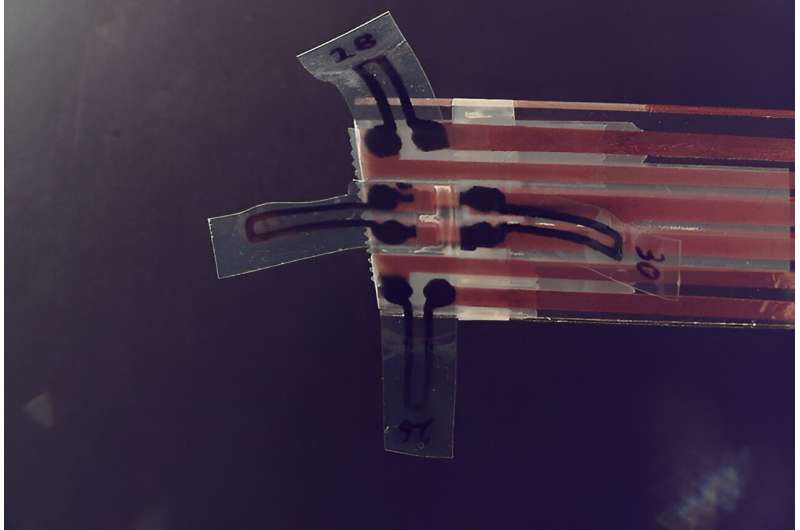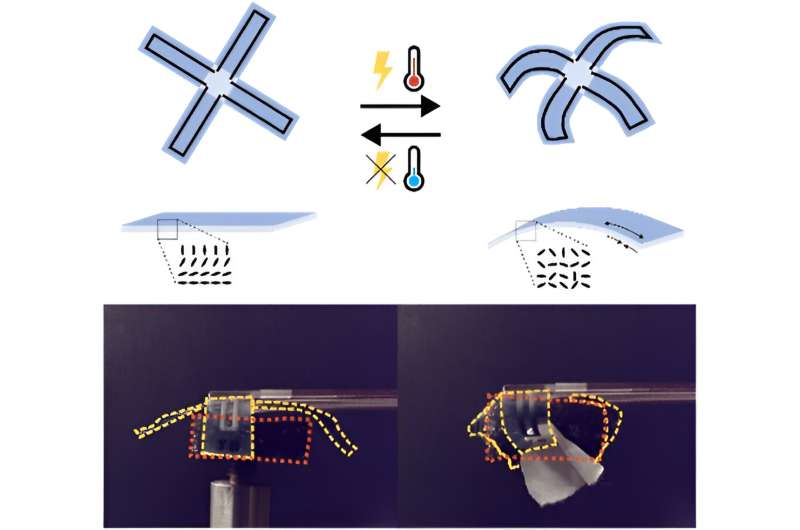
Eindhoven researchers have developed a smooth robotic “hand” created from liquid crystals and graphene that may very well be used to design future surgical robots. The brand new work has simply been revealed within the journal ACS Utilized Supplies & Interfaces.
In our future hospitals, smooth robots is likely to be used as surgical robots. However earlier than that may occur, researchers want to determine how one can exactly management and transfer these deformable robots. Added to that, many present smooth robots include metals, which implies that their use in water-rich environments—just like the human physique—is moderately restricted.
TU/e researchers led by Ph.D. candidate Laura van Hazendonk, Zafeiris Khalil (as a part of his grasp’s analysis), Michael Debije, and Heiner Friedrich have designed a smooth robotic hand or gripper created from graphene and liquid crystals (each natural supplies). This opens the probabilities for such a tool to be doubtlessly and safely utilized in surgical procedures sooner or later.
Robots have an unlimited affect on our world. For example, in trade, robots construct vehicles and televisions. In hospitals, robots—such because the da Vinci robotic surgical system—help surgeons and permits for minimally invasive operations. And a few of us even have robots to do our vacuum cleansing at residence.
“Society has turn into depending on robots, and we’re arising with new methods to make use of them,” says Van Hazendonk, Ph.D. researcher within the Division of Chemical Engineering and Chemistry. “However in devising new methods to make use of them, we want to consider utilizing several types of supplies to make them.”
Considering smooth
The completely different supplies that Van Hazendonk is referring to are fluids, gels, and elastic supplies—that are all simply deformable. “Sometimes, robots are created from metals, that are inflexible and laborious. However in sure purposes, robots created from laborious and inflexible supplies restrict the efficiency of the robotic,” says Van Hazendonk. “The answer is to assume smooth.”
In smooth robotics, the purpose is to make robots from supplies like fluids or gels that may deform in sure conditions after which can act like robots created from conventional inflexible and laborious supplies.
One space the place smooth robots look set to have a significant impression is in surgical procedures. Van Hazendonk provides, “For a surgeon, many operations may be complicated and delicate, and subsequently require exact dexterity on the a part of the surgeon. Generally this simply is not doable, and so they flip to robots.
“However inflexible robots could not have the ability to entry some areas with ease both. That is the place smooth robots can come to the fore, and our purpose was to supply the potential new serving to hand to be used in clamping and suturing used gadgets in surgical procedures, for instance.”
Turning to Nobel supplies
For his or her analysis, Van Hazendonk and her colleagues opted to make use of a distinct sort of deformable materials—liquid crystals—together with graphene to make a smooth gripper machine or “hand” with 4 controllable and deformable “fingers.”
Intriguingly, each liquid crystals and graphene are instantly or not directly related to Nobel Prizes in Physics during the last 30 years or so. Again in 1991, Pierre-Gilles de Gennes received the prize for his work on order in complicated matter, resembling liquid crystals. And in 2010, Andre Geim and Konstantin Novoselov received the prize for his or her work on graphene—the super-strong materials that can also be clear and an efficient conductor of electrical energy and warmth.
“A liquid crystal behaves as a liquid or a strong relying on how it’s excited or perturbed. When it flows, it acts like a liquid. However in particular conditions, the molecules within the liquid can prepare themselves to create a daily sample or construction, resembling a crystal you’ll see in a strong materials beneath a robust microscope,” explains Van Hazendonk. “The power for liquid crystal supplies to behave like that is excellent in relation to making smooth robots.”

Actuator problem
With the supplies chosen, the researchers got down to design and make an actuator. “Actuators management and regulate movement in robotic techniques. Often, the actuator responds or strikes when provided with electrical energy, air, or a fluid,” says Van Hazendonk. “In our work, we turned to one thing else to drive liquid-crystal community (LCN) actuators.”
The researchers designed a gripper machine with 4 ‘fingers’ managed utilizing LCN actuators which are deformed because of the impact of warmth on graphene-based heating parts or tracks within the fingers of gripper or ‘hand.”
Extra info:
Laura S. van Hazendonk et al, Sizzling Fingers: Individually Addressable Graphene-Heater Actuated Liquid Crystal Grippers, ACS Utilized Supplies & Interfaces (2024). DOI: 10.1021/acsami.4c06130
Eindhoven College of Know-how
Quotation:
New smooth robotic gripper designed with graphene and liquid crystals (2024, June 18)
retrieved 19 June 2024
from https://techxplore.com/information/2024-06-soft-robotic-gripper-graphene-liquid.html
This doc is topic to copyright. Other than any honest dealing for the aim of personal examine or analysis, no
half could also be reproduced with out the written permission. The content material is offered for info functions solely.
